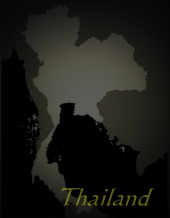
>Home: Map< Instruments Videos Articles Links Biography Contact Disclaimer

| Preface >Articles< Instruments Musicians Books + CDs Links _______________________  |
The Pi Phat: Thai or Khmer
ensemble?
An essay written by Ingo Stoevesandt The Pi Phat is a gong chime ensemble that is, like the “Mahori” ensemble, known in many countries of Southeast Asia. We find derivates of it in Myanmar, Malaysia, Laos and Cambodia, the latter with the “Pin Peat” of the Khmer. For all these countries one could say that the indigenous culture represents a mixture of Indian and Indonesian influencies, sometimes mingled with slight relicts of Chinese correspondings. But if it would be that easy, there would be no reason for a research in detail. Another reason for a detailed view of what is “Thai” or not is demanded by the Thai themselves. The incident between Thailand and Cambodia in 2002 showed once again how strong cultural and political aspects are bound to the cultural identity of a whole nation. It is the old struggle between the Siamese and the Khmer which is still kept alive between these two nations. Of course nobody in Thailand would deny the power of ancient Angkor Wat, as nobody in Cambodia would do with ancient Ayutthaya kingdom. But if we watch the timeline, it was the Siamese that invaded Angkor Wat, and this is the reason for the Khmer to point out the Thai would have “stolen” or overtaken cultural issues of the Angkorian empire and the Thai culture would indeed be of Khmer origin. On the other hand, the Thai could point out that even the old Angkor empire once invaded the northern regions of Thailand and this way overtook old habits from the Thai areas to build their powerful empire. This all increased in the demand for a “Thai-zation” of Angkor Wat in 2002. So, who is right now? Or is this the wrong question? The Pi Phat may be an example to show up difficulties in realising the “origin” of an ensemble, it is also thought as a sample for showing the loss of sense in a question for a national “identity” in the origin of a cultural habit. The Pi Phat is an ensemble that just by form is a derivate of the Javanese Gamelan ensemble. This way the Khmer would be the first to overtake an ensemble like this, as king Jayavarman II. of Angkor Wat was educated at the kings court of Java. (A small comparison based on the Thai Pi Phat and the Javanese Gamelan can be found here). On the other hand gong chime ensembles in every kind of appearance always remind us of the Indonesian ensembles and the impact of the Javanese court music traditions on mainland Southeast Asia. It is rather more questionable why this historical fact should have any negative effetcs on the Thai music of the Pi Phat - it still sounds as beautiful as it does in Cambodia, Malaysia and Laos. After all neither the Thai nor the Khmer were the first to “invent” gong chime ensembles like the Pi Phat. Otherwise, both countries found a way to integrate this ensemble into their royal court music. One could say both nations have been intelligent enough to know the possibilities of this ensemble. The Pi Phat as well as the Pin Peat share their musical heritage side by side in peace. Why shouldn't the Thai and Khmer people do this as well? |